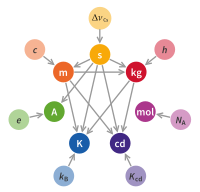
Photo from wikipedia
Beyond the high resolution/low mass range data traditionally used, a Kendrick mass defect analysis (KMD) using the new concept of fractional base units has been successfully conducted on low resolution/low… Click to show full abstract
Beyond the high resolution/low mass range data traditionally used, a Kendrick mass defect analysis (KMD) using the new concept of fractional base units has been successfully conducted on low resolution/low mass range and high resolution/high mass range data for the first time. Relying on a mathematical framework to rationalize the effect of the fractional base units, the electrospray ionization single stage and multistage mass spectra of a poly(vinylpyrrolidone) recorded from a low resolution ion trap analyzer were turned into information-rich KMD plots using vinylpyrrolidone/112 and pyrrolidone/86 as base units. The distributions detected in the matrix assisted laser desorption ionization spiralTOF mass spectra of high molecular weight poly(ethylene oxide) and poly(caprolactone) were conveniently discriminated in KMD plots using (ethylene oxide)/45 and caprolactone/113 as base units with an unprecedented resolution at such a mass range. The high resolution KMD analysis using fractional base units opens new perspectives for the acquisition, visualization, and presentation of mass spectra of polymers with less restrictions in terms of required resolution and molecular weights.
Journal Title: Analytical chemistry
Year Published: 2017
Link to full text (if available)
Share on Social Media: Sign Up to like & get
recommendations!